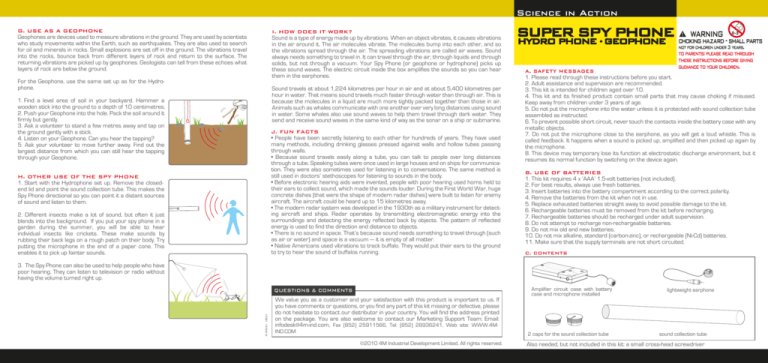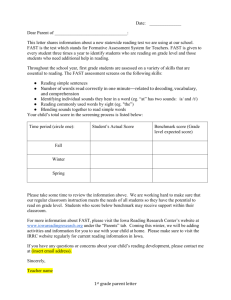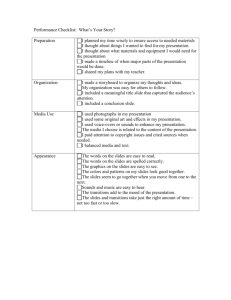
Science in Action
G. USE AS A GEOPHONE
Geophones are devices used to measure vibrations in the ground. They are used by scientists
who study movements within the Earth, such as earthquakes. They are also used to search
for oil and minerals in rocks. Small explosions are set off in the ground. The vibrations travel
into the rocks, bounce back from different layers of rock and return to the surface. The
returning vibrations are picked up by geophones. Geologists can tell from these echoes what
layers of rock are below the ground.
I. HOW DOES IT WORK?
Sound is a type of energy made up by vibrations. When an object vibrates, it causes vibrations
in the air around it. The air molecules vibrate. The molecules bump into each other, and so
the vibrations spread through the air. The spreading vibrations are called air waves. Sound
always needs something to travel in. It can travel through the air, through liquids and through
solids, but not through a vacuum. Your Spy Phone (or geophone or hydrophone) picks up
these sound waves. The electric circuit inside the box amplifies the sounds so you can hear
them in the earphones.
For the Geophone, use the same set up as for the Hydrophone.
Sound travels at about 1,224 kilometres per hour in air and at about 5,400 kilometres per
hour in water. That means sound travels much faster through water than through air. This is
because the molecules in a liquid are much more tightly packed together than those in air.
Animals such as whales communicate with one another over very long distances using sound
in water. Some whales also use sound waves to help them travel through dark water. They
send and receive sound waves in the same kind of way as the sonar on a ship or submarine.
1. Find a level area of soil in your backyard. Hammer a
wooden stick into the ground to a depth of 10 centimetres.
2. Push your Geophone into the hole. Pack the soil around it
firmly but gently.
3. Ask a volunteer to stand a few metres away and tap on
the ground gently with a stick.
4. Listen on your Geophone. Can you hear the tapping?
5. Ask your volunteer to move further away. Find out the
largest distance from which you can still hear the tapping
through your Geophone.
J. FUN FACTS
• People have been secretly listening to each other for hundreds of years. They have used
many methods, including drinking glasses pressed against walls and hollow tubes passing
through walls.
• Because sound travels easily along a tube, you can talk to people over long distances
through a tube. Speaking tubes were once used in large houses and on ships for communication. They were also sometimes used for listening in to conversations. The same method is
still used in doctors’ stethoscopes for listening to sounds in the body.
• Before electronic hearing aids were invented, people with poor hearing used horns held to
their ears to collect sound, which made the sounds louder. During the First World War, huge
concrete dishes (that were the shape of modern radar dishes) were built to listen for enemy
aircraft. The aircraft could be heard up to 15 kilometres away.
• The modern radar system was developed in the 1930th as a military instrument for detecting aircraft and ships. Radar operates by transmitting electromagnetic energy into the
surroundings and detecting the energy reflected back by objects. The pattern of reflected
energy is used to find the direction and distance to objects.
• There is no sound in space. That’s because sound needs something to travel through (such
as air or water) and space is a vacuum — it is empty of all matter.
• Native Americans used vibrations to track buffalo. They would put their ears to the ground
to try to hear the sound of buffalos running.
H. OTHER USE OF THE SPY PHONE
1. Start with the Hydrophone set up. Remove the closedend lid and point the sound collection tube. This makes the
Spy Phone directional so you can point it a distant sources
of sound and listen to them.
2. Different insects make a lot of sound, but often it just
blends into the background. If you put your spy phone in a
garden during the summer, you will be able to hear
individual insects like crickets. These make sounds by
rubbing their back legs on a rough patch on their body. Try
putting the microphone in the end of a paper cone. This
enables it to pick up fainter sounds.
SUPER
SPY PHONE WARNING
HYDRO PHONE • GEOPHONE choking hazard - small parts
not for children under 3 years.
to parents: please read through
these instructions before giving
gudiance to your children.
A. SAFETY MESSAGES
1. Please read through these instructions before you start.
2. Adult assistance and supervision are recommended.
3. This kit is intended for children aged over 10.
4. This kit and its finished product contain small parts that may cause choking if misused.
Keep away from children under 3 years of age.
5. Do not put the microphone into the water unless it is protected with sound collection tube
assembled as instructed.
6. To prevent possible short circuit, never touch the contacts inside the battery case with any
metallic objects.
7. Do not put the microphone close to the earphone, as you will get a loud whistle. This is
called feedback. It happens when a sound is picked up, amplified and then picked up again by
the microphone.
8. This device may temporary lose its function at electrostatic discharge environment, but it
resumes its normal function by switching on the device again.
B. USE OF BATTERIES
1. This kit requires 4 x ‘AAA’ 1.5-volt batteries (not included).
2. For best results, always use fresh batteries.
3. Insert batteries into the battery compartment according to the correct polarity.
4. Remove the batteries from the kit when not in use.
5. Replace exhausted batteries straight away to avoid possible damage to the kit.
6. Rechargeable batteries must be removed from the kit before recharging.
7. Rechargeable batteries should be recharged under adult supervision.
8. Do not attempt to recharge non-rechargeable batteries.
9. Do not mix old and new batteries.
10. Do not mix alkaline, standard (carbon-zinc), or rechargeable (Ni-Cd) batteries.
11. Make sure that the supply terminals are not short circuited.
C. CONTENTS
3. The Spy Phone can also be used to help people who have
poor hearing. They can listen to television or radio without
having the volume turned right up.
41-03914/1 180211
QUESTIONS & COMMENTS
We value you as a customer and your satisfaction with this product is important to us. If
you have comments or questions, or you find any part of this kit missing or defective, please
do not hesitate to contact our distributor in your country. You will find the address printed
on the package. You are also welcome to contact our Marketing Support Team: Email:
infodesk@4m-ind.com, Fax (852) 25911566, Tel: (852) 28936241, Web site: WWW.4MIND.COM
Amplifier circuit case with battery
case and microphone installed
2 caps for the sound collection tube
©2010 4M Industrial Development Limited. All rights reserved.
lightweight earphone
sound collection tube
Also needed, but not included in this kit: a small cross-head screwdriver
D. ASSEMBLY
1. Unscrew the battery case cover
and install the batteries. Replace
the cover and secure with a screw.
2. Plug in the earphone.
3. To avoid feedback, make sure the
earphone and the microphone
separated from each other. Slide
the switch to the ‘ON’ position.
4. The earphone should give out
some crackling sounds to indicate
that the device is working. If nothing
happens, check the batteries or
adjust the volume on the earphone.
5. Use a small flat screw driver to
adjust the volume as in diagram.
The volume is pre-set at medium
level.
6.Your Super Spy Phone is now
ready for use.
E. USE AS A SPY PHONE
Spies and detectives use high tech devices to pick up important information from the conversations of enemies. A real spy would plant the microphone in a hidden place such as a book
on a shelf. It might be attached to a door or even the outside of a window. Speech or other
sounds make doors and windows vibrate. This vibration is picked up by the microphone. The
smallest spy bug will now just fit over the full stop in this sentence.
While your Spy Phone may not be as sophisticated as the bugs that real spies use, you can
still experiment with picking up sounds as real spies do.
Picking up sound through walls
1. Ask a volunteer to go into a room with a radio and close the door. Tell him to turn the radio
on and increase the volume gradually, making sure that it is not so loud that people outside
the room can hear the sounds easily.
2. Put the microphone against the wall or door of the room
and listen on your Spy Phone. Can you hear anything? If not,
ask the volunteer to adjust the volume slightly. You should
be able to pick up the noise of the radio through the wall
with your Spy Phone.
3. Here’s another fun thing to do... hold the microphone in
contact with a mechanical clock or watch to hear the
tick-tock sound made by the mechanism.
Picking up sounds through windows
Picking
sounds through
windows
Hold theupmicrophone
against
the windows and see what
1.
Hold the
against
the windows
and see
what
sounds
you microphone
can pick up. Can
you hear
dogs barking
or birds
sounds
youTry
can
pick up. the positions of your Spy Phone to
chirping?
adjusting
2.
hear signals.
dogs barking or birds chirping?
getCan
theyou
optimal
3. Try adjusting the positions of your spy phone to get the
optimal signals.
Picking up sounds through a string
Picking
upends
sounds
a string
1. Tie the
of athrough
10-metre
piece of string or thread to
1.
thepulls
endsofoftwo
a 10m
piece
string
to the ring pulls of
theTie
ring
empty
soft of
drink
cans.
two
softa drink
cans.to take one of the cans and move away
2. Ask
volunteer
2.
Askthe
a volunteer
to take one of the cans and move away
until
string is taut.
until
thethe
string
is taut. against the bottom of the can you
3. Hold
microphone
3.
the microphone against the bottom of the remainareHold
holding.
ing
can.your volunteer to tap his or her can or speak against
4. Ask
4.
the volunteer
to tap his can or speak against the
theAsk
bottom
of the can.
bottom
of the
can.
5. Can you
hear
the tapping or what the volunteer is saying
5.
the tapping
or what
the volunteer
is saying
onCan
youryou
Spyhear
Phone?
The sound
is traveling
along the
string!
using your spy phone? The sound is traveling along the
string!
Picking up sounds through pipes
Picking
Sounds up
cansounds
travel through
very longpipes
distances along metal pipes.
Sounds
veryyour
longSpy
distances
You cancan
testtravel
this with
Phone.through water in
pipes.
can testtothis
Spy Phone
1. AskYou
a volunteer
go out
intowith
youryour
bathroom
and hit the tap
1.
Ask with
a volunteer
lightly
a pencil.to go into the bathroom and strike the
tap
lightlyyour
withSpy
a pencil.
2. Take
Phone into the kitchen. Hold the micro2.
Takeagainst
your hydrophone
phone
the kitcheninto
tap.the kitchen. Hold the microphone
the
tap.
3. Canagainst
you hear
the
tapping in the earphone?
3.
the tapping
the earphones.
4. You
Ask can
the hear
volunteer
in the via
bathroom
to speak a secret
4.
Ask theinto
volunteer
in the
bathroom
to speak
secret
message
a plastic
bottle
held close
to the atap.
message
a plastic
bottleSpy
held
closeand
to the
5. Listen into
carefully
on your
Phone
seetap.
if you can
5.
carefully
your hydrophone and see if you can
pickListen
up the
secret on
message.
pick up the secret message.
F. USE AS A HYDROPHONE
Hydrophones are special microphones that are used underwater to pick up sounds. They are
used in submarines to detect sounds from other submarines or ships. Submarines use
sonar to detect sounds, and hydrophones are the heart of sonar. ‘Blips’ of sound are sent out
and picked up by a hydrophone when the ‘blips’ are reflected from a solid surface such as
another submarine. By looking at the length of time it takes for the echo ‘blip’ to return, the
submarine crew could work out the distance from the other submarine. Hydrophones can
even detect sound from within a submarine. That is why the crew has to remain silent if they
think a ship is trying to locate them, especially during warfare.
1. Slide the “C” shaped plastic lid onto the wire of the
microphone.
2. Plug the lid to one end of the sound tube provided.
3. Plug the other lid to the other end of the sound tube.
1
2
3
Fill your sink or a bucket with water. Put the sound tube of
the hydrophone into the water so that it is half submerged.
Hold the tube in position. Now flick the water surface with
your finger, or tap the rim of the sink or bucket. The Hydrophone should pick up the sound.
Further experiment
Adult permission and supervision are required here.
1. You need a music device such as an MP3 player or a
radio, with a small earphone plugged in.
2. Find a used plastic bottle. Clean it up and leave it to dry.
3. Insert the earphone to the bottle.
4. Cover the bottle with plastic wrap and use a rubber
band to keep the plastic tight around the bottle neck. Turn
on the music and set the volume to loud. Hold the bottle in
the water so that the bottom half is submerged. Now
place your Hydrophone into the water, also half
submerged. You will be able to listen to the music through
your Hydrophone.






